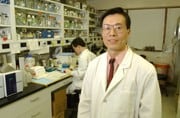UAMS Expert Backs Animals-to-Humans Link in SARS
| LITTLE ROCK – An expert on coronaviruses – the suspects in the respiratory outbreak SARS – at the University of Arkansas for Medical Sciences (UAMS) supports the theory that the new respiratory illness may have jumped from animals to humans.
Xuming Zhang, Ph.D., in 1994 linked one human coronavirus to a disease of cattle.
“I suspected that coronaviruses are a kind of zoonosis, or disease that spreads from animals to humans,” Zhang says.
Although the origin of the new coronavirus is unknown, the virus’s sudden transformation from an agent that attacks animals into one that attacks humans would explain the mysterious outbreak of SARS, or severe acute respiratory syndrome, that began in November in Asia and has affected an estimated 3,000 persons, killing about 100.

Xuming Zhang, Ph.D., in his laboratory at the University of Arkansas for Medical Sciences.
Zhang is one of a few scientists in the United States studying coronaviruses in animals and humans. He is an associate professor in the Department of Microbiology and Immunology in the UAMS College of Medicine and a member of the Arkansas Cancer Research Center at UAMS. Zhang first reported the cattle-to-human link in diarrhea-causing coronaviruses in 1994, while working at Louisiana State University. He has current research funding from the National Institutes of Health and is an advisor to the U.S. Department of Agriculture.
Zhang and colleagues in Germany reported in the Journal of Medical Virology in 1994 that they had isolated a new strain of the virus obtained from patients with acute gastroenteritis or necrotizing enterocolitis. The new strain had more in common with a virulent form of coronavirus that affects cattle than with the previously-known human coronavirus that caused mild respiratory illnesses.
While there are many forms of coronavirus, so called because of the viruses’ resemblance to a crown, only two were known to affect humans until the outbreak of SARS. One form was believed to cause about 20 percent of the cases of the common cold, or mild respiratory illness; the other causes diarrhea and necrotizing enterocolitis and is the type that Zhang identified as evolving from a cattle disease.
The outbreak of SARS has caused widespread concern because it apparently spreads through the air when infected persons cough or sneeze, making it very easy to contract in crowded cities.
A biotechnology company has approached Zhang about testing an antiviral drug as a possible treatment for SARS. According to Zhang, while the easy spread of the virus is a serious public health problem, the SARS virus appears to be a type of coronavirus that is relatively easy to kill with detergents and antiseptics.
A coronavirus is considered the most likely cause of SARS, although other viruses are still under investigation as possible causes. SARS generally begins with a fever greater than 100.4 degrees Fahrenheit. Other symptoms may include headache, body aches and an overall feeling of discomfort. After a few days, SARS patients may develop a dry cough and have trouble breathing. It is easily misdiagnosed as influenza or other ailments with similar symptoms.
President Bush recently added SARS to the list of diseases for which people can be quarantined in the United States. China, Vietnam, Canada, Taiwan and Singapore have used quarantines to contain the problem. So far Hong Kong, where more probable cases have been reported in the last two weeks than in the rest of the world combined, has resisted a quarantine for its patients.
SARS was first reported in the Guangdong Province of China in November, and shortly after that in Hong Kong and Hanoi, Vietnam. It quickly spread to many other countries. SARS has been blamed for killing more than 100 and making more than 2,700 ill worldwide. One hundred and seventy-eight suspected cases have been reported in the United States, all but twelve of them involve people who were infected while traveling in Asia. The rest are family members of a person with SARS, health workers who came in close contact with one, and one co-worker.
Click here for print-quality resolution of Xuming Zhang, Ph.D.